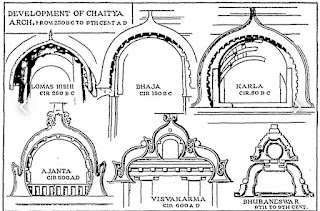The Arched-hill symbol is a symbol on ancient Coinage of India. There are some variations to the number of hills depicted, or the symbol surmounting the hill, such as a crescent or a star.
It is believed that the three -arched hill symbol was initiated in the 3rd to 2nd century BCE by the Maurya Empire.
Later in the coins from Taxila from 220 BCE, the three arched symbol appears regularly and from 185 BCE is regularly associated with the animal figures of the elephant and the lion.
Taxila, copper 1/4 Karshapana, weight 2.2 g
Obverse: Three-arched hill (chaitya), crescent above, Brahma legend
Reverse: Three-arched hill, crescent above
It has also been believed to be the imperial symbol of the Mauryas, though it appears in many post-Mauryan coins of Taxila and the Shungas.
The symbol is considered a representation of the "Buddhist Chaitya" or a "Meru".
Chaitya. means "heaped up" and is a Sanskrit word for a mound or pedestal or 'funeral pile'. It is a sacred construction of some sort and has acquired a different and specific meaning in different regions. Early chaityas enshrined a stupa with space for worship by monks.
In Buddhism it refers to a space with a stupa and a rounded apse at the end opposite the entrance and a high roof with a rounded profile. Outside India, the term is used by Buddhists for local styles of small stupa like monuments in Nepal, Cambodia, Indonesia and other countries. In historic texts of Jainism and Hinduism, including those related to architecture, Chaitya refers to a temple, sanctuary or any sacred monument.
Meru. Mount Meru is also recognized as Sumeru, Sineru or Mahameru, the sacred five peak mountain of Hindu, Jain and Buddhist cosmology and is considered to be the center of all the physical, metaphysical and spiritual universes. Meru is also the central bead in a "mala". Mount Meru is known in Burma, China, Japan, Korea, Thailand, Vietnam and several other countries.
The cosmic tortoise, and Mount Meru
In Hinduism, Mount Meru is described as 84,000 yojanas high, about 1,082,000 km, which is 85 times the earth's diameter. The sun along with all other planets in the solar system revolve around Mt Meru as one unit. The Matsaya Purana and the Bhagvata Purana, Vishnu Purana along with some other texts, consistently give the height of 84,000 yojanas to Mount Meru and it is said to be the residence of Brahma.
Three-arched hill symbol on some other coins
Taxila, Pushkalavati, 2nd century BC, 1/4 Karshapana, weight 2.0 g
Obverse: Chaitya or crescent three-arched hill, taurine at right
Reverse: Chaitya or three-arched hill, taurine at right
There were variants to the three-arched hill symbol, such as the 'six-arched hill' and the 'eight-arched hill' symbols on coins.
























No comments:
Post a Comment
Any inputs or feedback is welcome!